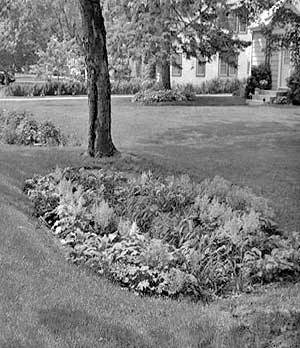Small Home Gazette, Spring 2010
Maintaining Your Rain Garden
Rain gardens continue to be a growing interest for urban and shoreland dwellers. Once a rain garden is established, maintenance can be minimal, although some weeding is required. Here are some simple recommendations that will help ensure a fully functioning rain garden.
 During the Initial Planting Year:
During the Initial Planting Year:
- Weed throughout the growing season; remove the entire plant. Weed seeds may have been introduced during site preparation and if either soil or compost was added. Remove weed species so they do not compete with the plants you want in your garden.
- Watering may be necessary during dry periods to help the young plants establish strong root systems, which will help them survive winter. Deep root systems increase infiltration so it is recommended to water about 1 inch once a week rather than small amounts more frequently.
- Fertilizing is not recommended and not needed when native plant species are used.
Spring:
- Clear sediment and debris from the areas where water flows into the rain garden. This may or may not be an issue depending on the source of the runoff. A rain garden located near a driveway or road may have sand, gravel or other materials that should be removed.
- If down spouts are your source of water, make sure the vegetation has not been scoured out by the force of water from snowmelt. If scouring occurred, replace the vegetation or lay a rock bed down in the area instead.
- Remove excessive plant material. It is best if you do this in the spring as the plant material helps to protect the plants from overwinter damage and seed heads may provide food for winter birds.
- Replace plants that did not survive the winter.
- Clean up trash—most will accumulate at the inlets.
- If you have shrubs or trees in your rain garden, prune out the dead material every year. You may also trim shrubs if necessary, although it is not required. It is generally best to prune shrubs before they leaf out.
- Add mulch to bare spots.
Early Summer:
- Check for weeds and remove if necessary. You should not have to weed more than once a year but there may be a few plants that you will want to eliminate before they go to seed.
Winter:
- Do not use the rain garden areas to pile excess snow from driveways or roads as this may also contain a lot of sediment and may fill or plug up the rain garden.
Note on Weeding:
Keep a list of the plants you planted. It will help you distinguish weeds from desirable species. Remember that early in spring new growth does not always resemble what the mature plant will look like. To help identify common garden weeds go to: www.extension.umn.edu/gardeninfo/weedid/index.html.
Printed in “From Shore to Shore” newsletter; used with permission.











